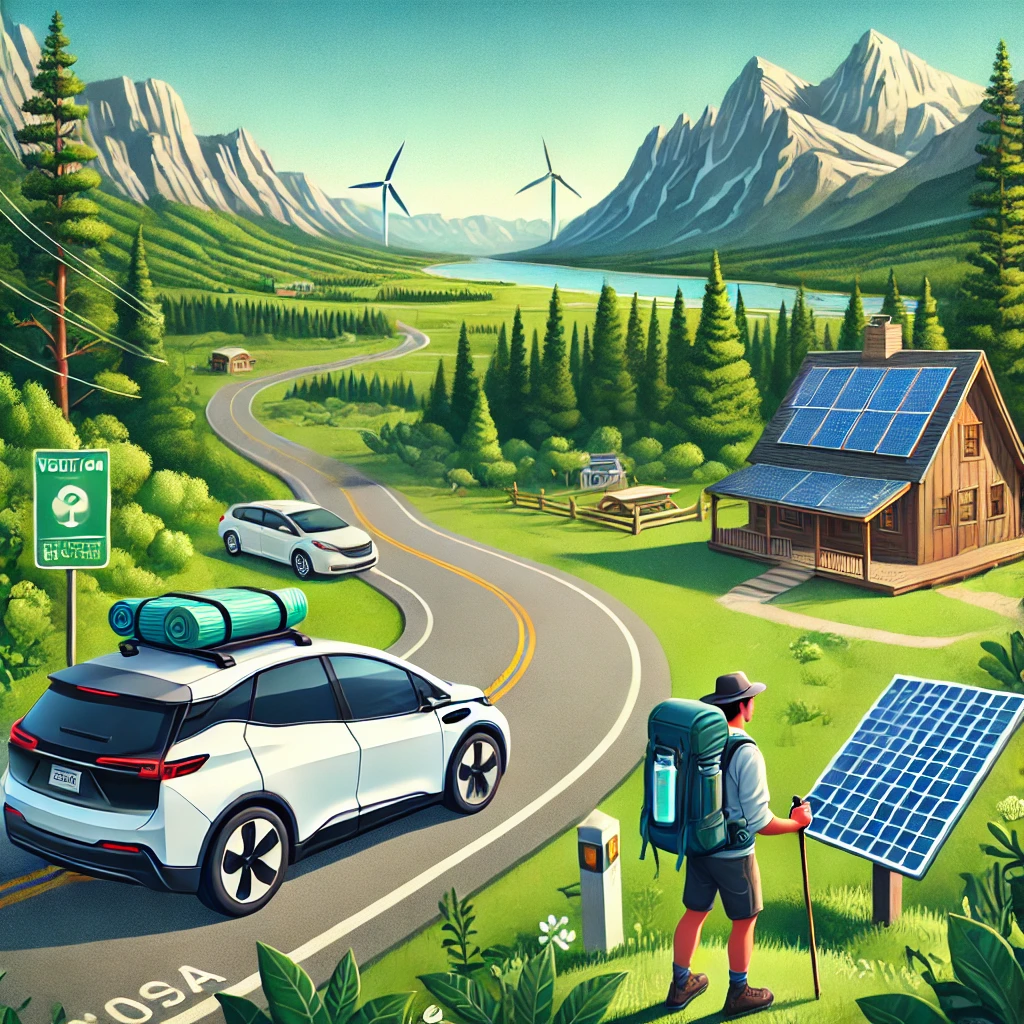In 2025, with climate change at the forefront of global concerns, more travelers are becoming conscious of their environmental footprint. The travel industry is a significant contributor to greenhouse gas emissions, accounting for about 8% of global emissions. However, making more eco-conscious decisions while exploring the U.S. can significantly reduce your environmental impact. This guide provides practical tips on how to travel sustainably in 2025, offering actionable steps to minimize harm to the environment while still enjoying memorable experiences.
The Impact of Travel on the Environment
 The travel and tourism sector is one of the largest sources of carbon emissions. Air travel alone contributes roughly 2.5% of global carbon dioxide emissions, while road transport and accommodation are also significant contributors. In the U.S., personal cars are responsible for about 45% of transportation-related emissions. As travel increases in 2025, it’s crucial to address these impacts by adopting sustainable practices. Travelers can make informed choices about transport and accommodation that reduce their carbon footprint.
The travel and tourism sector is one of the largest sources of carbon emissions. Air travel alone contributes roughly 2.5% of global carbon dioxide emissions, while road transport and accommodation are also significant contributors. In the U.S., personal cars are responsible for about 45% of transportation-related emissions. As travel increases in 2025, it’s crucial to address these impacts by adopting sustainable practices. Travelers can make informed choices about transport and accommodation that reduce their carbon footprint.
According to the International Council on Clean Transportation, improvements in vehicle efficiency and an increase in electric vehicle (EV) adoption could lower emissions in the U.S. by as much as 30% by 2030. However, changes need to start now. Reducing the environmental impact of travel in 2025 requires conscious decisions regarding transport and accommodation.
Eco-Friendly Transportation Options
 Electric Vehicles (EVs) are becoming a leading choice for sustainable travel within the U.S. As of 2025, there are more than 2 million electric vehicles on U.S. roads, with charging infrastructure expanding rapidly. Opting for an EV on road trips or renting one for city travel can cut emissions by over 50% compared to traditional gas-powered cars.
Electric Vehicles (EVs) are becoming a leading choice for sustainable travel within the U.S. As of 2025, there are more than 2 million electric vehicles on U.S. roads, with charging infrastructure expanding rapidly. Opting for an EV on road trips or renting one for city travel can cut emissions by over 50% compared to traditional gas-powered cars.
For shorter distances, consider public transportation. Cities like New York, Portland, and San Francisco have highly efficient subway, bus, and tram systems, significantly reducing the environmental impact of daily travel. In addition, Amtrak’s growing electric fleet offers a sustainable alternative to car and plane travel for longer distances across the U.S.
Flying less frequently and choosing direct flights where possible is another critical step. While air travel will continue to be necessary for many long-distance trips, selecting airlines with carbon offset programs or those using biofuels can help minimize the environmental damage. According to the Environmental Protection Agency (EPA), carbon offset programs can neutralize a portion of your flight emissions by investing in projects that reduce carbon dioxide in the atmosphere, such as reforestation efforts.
For further information on carbon offset programs and sustainable transport initiatives, visit EPA’s Guide to Carbon Offset.
Green Accommodation Choices
 Staying in eco-friendly accommodations is another critical aspect of sustainable travel. In 2025, an increasing number of hotels in the U.S. are obtaining green certifications such as LEED (Leadership in Energy and Environmental Design) or Green Key. These certifications ensure that hotels meet high environmental standards, including energy efficiency, water conservation, and sustainable waste management practices.
Staying in eco-friendly accommodations is another critical aspect of sustainable travel. In 2025, an increasing number of hotels in the U.S. are obtaining green certifications such as LEED (Leadership in Energy and Environmental Design) or Green Key. These certifications ensure that hotels meet high environmental standards, including energy efficiency, water conservation, and sustainable waste management practices.
For a more immersive experience, consider eco-lodges and sustainable Airbnbs. These options often use renewable energy sources, like solar power, and prioritize waste reduction and local sourcing of materials and food. Popular platforms like Booking.com and Airbnb now offer filters to search for eco-friendly options, making it easier to find sustainable accommodations.
Camping in national parks or forests is another low-impact option, particularly if you follow Leave No Trace principles, which emphasize minimizing waste and preserving the natural environment. Always choose campgrounds that encourage environmentally sound practices.
Sustainable Activities and Destinations
 Some of the most rewarding travel experiences in the U.S. involve connecting with nature through activities like hiking, kayaking, and wildlife watching. The key to sustainable exploration is choosing destinations and activities that prioritize environmental conservation. For example, many national parks, including Yosemite and Yellowstone, have taken significant steps to protect fragile ecosystems while promoting low-impact tourism.
Some of the most rewarding travel experiences in the U.S. involve connecting with nature through activities like hiking, kayaking, and wildlife watching. The key to sustainable exploration is choosing destinations and activities that prioritize environmental conservation. For example, many national parks, including Yosemite and Yellowstone, have taken significant steps to protect fragile ecosystems while promoting low-impact tourism.
Visitors should practice sustainable behaviors in these parks by sticking to designated trails, respecting wildlife habitats, and avoiding single-use plastics. National parks are also expanding eco-friendly infrastructure, such as electric shuttle buses, to reduce the environmental toll of high tourist volumes.
Similarly, cities like Portland and Seattle are leading the way in urban sustainability, offering extensive green spaces, bike-sharing programs, and zero-emission public transportation. Visiting cities with strong sustainability programs helps ensure your travels leave a smaller carbon footprint.
How to Reduce Your Travel Carbon Footprint
 Reducing your carbon footprint while traveling involves more than just transport and accommodation choices. Here are some practical steps to further minimize your environmental impact:
Reducing your carbon footprint while traveling involves more than just transport and accommodation choices. Here are some practical steps to further minimize your environmental impact:
- Pack reusable items: Carry reusable water bottles, cutlery, and shopping bags to reduce the amount of single-use plastic waste.
- Choose local and sustainable products: Support local businesses that prioritize sustainable practices. Look for organic, fair-trade, and locally sourced foods, which reduce the carbon footprint of transport and production.
- Offset your carbon emissions: Use verified programs like Terrapass or Carbonfund.org to offset the emissions from your flights and accommodation stays. These organizations fund renewable energy projects and reforestation efforts to neutralize carbon output.
Check out more ways to reduce your travel footprint on ayushjeevan.com, which offers extensive tips on sustainable living and eco-friendly travel.
Future Trends in Eco-Friendly Travel
 The future of sustainable travel looks promising, with technological advancements paving the way for more eco-friendly travel methods. One emerging trend is the development of electric aircraft, which promises to significantly reduce aviation-related emissions. Several companies, including Joby Aviation and Vertical Aerospace, are set to launch electric air taxis by the mid-2020s, offering a greener alternative for short-haul flights.
The future of sustainable travel looks promising, with technological advancements paving the way for more eco-friendly travel methods. One emerging trend is the development of electric aircraft, which promises to significantly reduce aviation-related emissions. Several companies, including Joby Aviation and Vertical Aerospace, are set to launch electric air taxis by the mid-2020s, offering a greener alternative for short-haul flights.
Moreover, the rise of smart tourism means that cities and destinations are investing in technologies to manage tourist flows more sustainably, using data to reduce overcrowding and mitigate environmental impact. By 2025, expect to see more eco-conscious travelers influencing the market, driving demand for green travel solutions across the U.S.
Traveling the U.S. in 2025 with minimal environmental impact is possible through thoughtful planning and conscious decision-making. By choosing eco-friendly transport, staying in green accommodations, and engaging in sustainable activities, you can explore the U.S. while reducing your carbon footprint. As the travel industry continues to evolve, embracing these practices will not only preserve the planet but also enhance the quality of your travel experiences.


